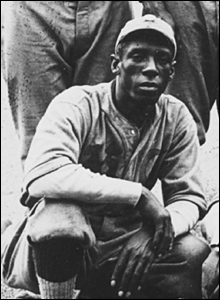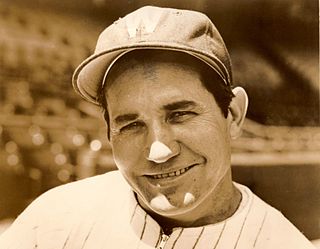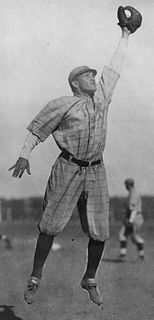Related Research Articles

Adolfo Domingo De Guzmán "Dolf" Luque was a Cuban starting pitcher in Major League Baseball (MLB) from 1914 to 1935. Luque was enshrined in the Cuban Baseball Hall of Fame and the Cincinnati Reds Hall of Fame in 1967, as well as in the Mexican Baseball Hall of Fame in 1985. Luque was not only the first Latino pitcher in MLB, but also the first to win a World Series victory, and the first to lead the Leagues in wins and shutouts.

Miguel Angel González Cordero was a Cuban catcher, coach and interim manager in American Major League Baseball during the first half of the 20th century. Along with Adolfo Luque, González was one of the first Cubans or Latin Americans to have a long off-field career in the U.S. Major Leagues.

José de la Caridad Méndez was a Cuban right-handed pitcher and manager in baseball's Negro leagues. Born in Cárdenas, Matanzas, he died at age 41 in Havana. Known in Cuba as El Diamante Negro, he became a legend in his homeland. He was one of the first group of players elected to the Cuban Baseball Hall of Fame in 1939. He was elected to the U.S. National Baseball Hall of Fame in 2006.
The Cuban League was one of the earliest and longest lasting professional baseball leagues outside the United States, operating in Cuba from 1878 to 1961. The schedule usually operated during the winter months, so the league was sometimes known as the "Cuban Winter League." It was always a small league, generally 3 to 5 teams, and was centered in Havana, though it sometimes included teams from outlying cities such as Matanzas or Santa Clara. The league became racially integrated in 1900, and during the first half of the 20th century the Cuban League was a premier venue for black and white players to meet. Many great black Northern American players competed in Cuba alongside native black and white Cuban stars such as José Méndez, Cristóbal Torriente, Adolfo Luque, and Martín Dihigo. After 1947, the Cuban League entered into an agreement with Major League Baseball and was used for player development. Following the 1959 Cuban Revolution, however, tensions rose with the new Communist government, and in March 1961 the government decreed the abolition of professional baseball.
The Habana club was one of the oldest and most distinguished baseball teams in the old Cuban League, which existed from 1878 to 1961. Habana, representing the city of Havana, was the only team to play in the league every season of its existence and was one of its most successful franchises. In their early history they were known by their colors as the Reds; later they adopted the names of Leones or Lions. Throughout their existence they had a famous rivalry with Almendares.

Conrado Eugenio Marrero Ramos, nicknamed "Connie", was a Cuban professional baseball pitcher. The right-handed Marrero pitched in Major League Baseball from 1950 to 1954 for the Washington Senators. Marrero made his major league debut when he was 38 years old, and was one of the oldest players in the league throughout the duration of his time in the major leagues. He was a popular star in his native Cuba, where he had a long and successful career in amateur baseball, pitching for Cuba in several Amateur World Series competitions, and playing several excellent seasons with the professional Cuban League and the minor league Havana Cubans. His nicknames in Cuba were "El Guajiro de Laberinto", reflecting his rural origins, "El Premier", and "El Curvo."
The Cuban Baseball Hall of Fame is a hall of fame that honors eminent baseball players from Cuban baseball. Established in 1939 to honor players, managers, and umpires in the pre-revolution Cuban League, by 1961 it had honored 68 players, managers, and umpires whose names are shown on a marble plaque at Havana's Estadio Latinoamericano. After the revolution, however, the Hall of Fame languished for more than 50 years, seldom mentioned or acknowledged and with no new inductees. Following a campaign led by Cuban filmmaker Ian Padrón, a meeting was held on November 7–8, 2014 to reformulate the Hall of Fame and to propose a museum in which it would be housed. The reformulated Hall recognized the original 68 members, and a jury of 25 people selected 10 new inductees—five from the pre-revolution period and five representing for the first time the post-revolution Cuban National Series. The planned site for the new museum is in the José Antonio Echeverría Workers' Social Club.

José Rodríguez, nicknamed "Joseíto" or "El Hombre Goma" in Spanish and "Joe" in English, was a Cuban infielder who played in Major League Baseball from 1916 to 1918 and in the Cuban League from 1914 to 1939. In the majors, he played for the New York Giants and was primarily a second baseman, while in the Cuban League and the U.S. minor leagues he mostly played first base. A defensive specialist, according to Roberto González Echevarría, Rodríguez "was considered the best defensive first baseman in Cuba" of his time. He was also a long-time manager in the Cuban League and managed for one season in the minors. He was inducted into the Cuban Baseball Hall of Fame in 1951.
The American Series was a set of baseball games played between Cuban and American teams in Cuba. An American team would travel to Cuba and play various professional, all-star and/or amateur Cuban teams throughout the country. The series usually took place either in the fall, after the end of the American season, or during spring training before the season began. The first American Series took place in 1879, with then minor league Worcester team going 2–0 against its Cuban opponents.
The Leopardos de Santa Clara were a Cuban professional baseball team based in Santa Clara, Cuba. Founded in 1922, they played in the Cuban League from 1922 to 1925, from 1929 to 1930, and from 1935 to 1941. Although they competed for only 11 seasons, they won league championships in four regular seasons and in one "special season." According to Cuban League historian Jorge S. Figueredo, the 1923/24 team, which went 36–11 and won the championship by 11+1⁄2 games, is "considered as the most dominant team in the history of Cuban baseball."
Club Fé were a Cuban baseball team in the Cuban League based in Havana. They played in 1882, 1885, from 1887-1890, and again from 1901 to 1914.

Antonio María García Callaghan, nicknamed "El Inglés", was a Cuban baseball catcher in the Cuban League. He played from 1882 to 1905 with several Cuban ballclubs, including Almendares, the Fe club, Habana, and the All Cubans. He was elected to the Cuban Baseball Hall of Fame in 1939.

Moisés Quintero Cavada was a Cuban baseball catcher in the Cuban League and Negro leagues. He played from 1887 to 1904 with Habana, Progreso, Almendares, the All Cubans, and Club Fé. He was elected to the Cuban Baseball Hall of Fame in 1953.
The Marianao baseball club played in the Cuban Professional League between the 1922–1923 and 1960–1961 seasons. The club represented the populous town of Marianao in Havana and played their games at La Tropicana Stadium, official site of the league.

Andrés Fleitas [flei'-tasz] was a professional Cuban baseball catcher and first baseman. Listed at 5' 11", 175 lb., he batted and threw right handed.

Eleno Agapito Mayor Valenzuela was a Cuban professional baseball pitcher. Listed at 5' 11", 185 lb., he batted and threw left handed.

Emilio Sabourín was a Cuban baseball second baseman and manager in the Cuban League. He played for Habana for six years, from 1878 to 1887, and later managed the club for several seasons. He played a role in the Cuban War of Independence, and was arrested by Spain in 1896. Sabourín died in prison in 1897. He was elected to the Cuban Baseball Hall of Fame in 1941.
The Orientals were a Cuban baseball team in the Cuban League based in Havana. They played during the winter of 1916-1917 and Armando Marsans served as manager.
Juan Antiga y Escobar was a Cuban baseball player, physician, homeopath, government official, and diplomat, who served as an ambassador to France and Switzerland and delegate to the League of Nations.
Matanzas was a Cuban baseball team in the Cuban League based in Matanzas. They first played in the league's inaugural season of 1878, then played in the league from 1888 to 1890, 1892–1894, and in 1907–1908.
References
- ↑ Figueredo, Jorge S. (2003). Cuban Baseball: A Statistical History, 1878-1961. McFarland & Company. ISBN 978-0-7864-6425-8.
- ↑ Figueredo 2003, p. 13.
- ↑ Figueredo 2003, p. 16.
- ↑ Figueredo 2003, p. 24.
- ↑ Figueredo 2003, p. 33.
- ↑ "Is Gen. Garcia in Cuba?". The Sun . 1896-03-26. p. 1. Retrieved 2021-05-13– via Newspapers.com.CS1 maint: discouraged parameter (link)
- ↑ "Cuban Baseball Hall of Fame". Seamheads.com. Retrieved May 13, 2021.CS1 maint: discouraged parameter (link)